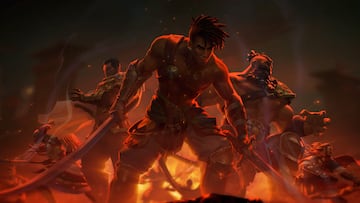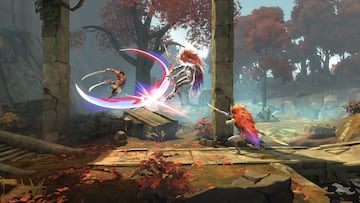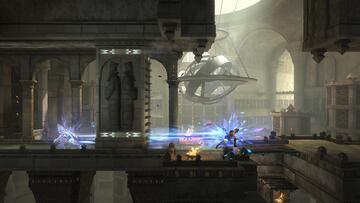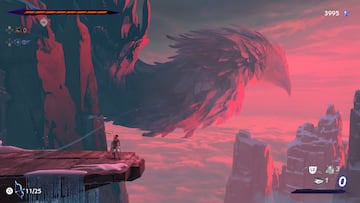Ubisoft
Prince of Persia: The Lost Crown - a new member of Metroidvania royalty
Prince of Persia returns with an astounding new Metroidvania title that manages to break all expectations while taking risks unthinkable for most AAA studios. Here’s our review.

It’s been 14 years since the last Prince of Persia was released back in the seventh generation of consoles. Ever since, what was once a flagship franchise for Ubisoft went unnoticed by newer audiences, missing an entire hardware generation. So it was a total surprise to hear that, apart from a planned remake of an older title, the franchise would return in a new game, and as a Metroidvania of all genres.
At that time many disregarded the game as a simple game, seeing the change to 2D platforming and combat as a downgrade, and didn’t pay much attention to it since. But with only a few days before its release, and having sunk dozens of hours into it, we’re here to tell you that Prince of Persia: The Lost Crown is not only one of the best Metroidvania titles that fans of the genre have played since Hollow Knight, but also one of the finest titles released by Ubisoft in over two decades.
A prince, a villain, and seven immortals walk into a time loop…
From the moment The Lost Crown begins, it is obvious that this is not what fans of the series expected at any moment. With a heavily stylized comic book style, plenty of momentum to all of its animations, and an almost anime-like excitement to every movement shown on screen, this new PoP opens with a quick exposition about who our hero, Sargon, is. Part of the seven Immortals of Persia, the kingdom’s most powerful warriors, he and the group destroy an invading army and save the day like it’s nothing.

But during the celebration, a betrayal takes place, and the Prince is kidnapped. The Queen tasks the heroes with retrieving the royal, and immediately they travel to Mount Qaf, an abandoned citadel that once was the seat of power, but that since has been abandoned. As they enter, they are faced with the corpses of the very allies that were riding just ahead of them, and become trapped in a realm in which time doesn’t flow normally, things are never as they seem, and gods and mortals intermingle like equals.
It’d be a disservice to the story and future players to get too much into the details of the plot here, but it’s enough to explain that at almost every moment of the game, mysteries keep piling up as you explore the cursed citadel where the game takes place. Little by little things are revealed to the player not only by cutscenes but through environmental storytelling, new characters, quests, and artifacts hidden around the world. There is much to discover as you journey through Mount Qaf, so its up to the player to find out what exactly happened in this ruined world.

Of course, with this being a Metroidvania, it means that you’re only really limited by whatever abilities you have at the moment. The map of this game is incredibly large, and from the moment you step foot in the world veteran explorers will start to see hints that’ll pull them to come back after acquiring new abilities or powers to reach hidden areas. If you can see something you cant access yet, it’s almost certain you’ll be able to do so just a few hours down the line.
Time powers and acrobatics, with a little bit of Devil May Cry
Of course, having a big map to explore would mean nothing if you didn’t have a little bit of action in between treasures. And The Lost Crown doesn’t disappoint. Combat can be as simple or complex as you wish to make it, being caple of mashing your way to victory with only a couple of dodges needed, to a stunning ballet of combos thanks to dodges, perfect parries, air juggles, and super attacks that can help you dominate the battlefield with style.

Indeed, you might have already seen a couple of compilations on Twitter/X of some dedicated players that, just with the demo, have unleashed amazing combos on the games’ poor initial enemies, a few simple zombies. But as you progress through the world and its many biomes you’ll grow accustomed to basically everything in your arsenal just to survive. Parries will become essential as you discover you can reflect projectiles and still keep pressure on a shielded enemy in front of you while getting pelted by ranged monsters. Dodging gets a bit more complex when big brutes swing over their heads, reaching in front and behind them forcing you to measure your movement. Eventually you’ll find soldiers capable of parrying your attacks, and you’ll suddenly find yourself on the defensive.
Combat is simply exhilarating, with a wide variety of tools at your disposal that only gets larger as you acquire new powers and upgrades. But at the same time, those additions are there to help you navigate the world with swift movement. The previously mentioned time powers vary greatly on what you can do, but they go from interdimensional hopping to make platforms appear and disappear, to placing a clone of Sargon to which you can return after moving, to reposition yourself.

Of course, you’ll find more common upgrades like dashes and double-jumps, mainstays of the Metroidvania toolkit since its origins, but even these upgrades have a fantastic look to them that makes them especially fun to use. By far my favorite is one of the first you ever get, called Rush of the Simurgh. This ability lets you dash forward through the air, but when you look closely at it it’s actually Sargon running on a spectral wall, just as in older Prince of Persia games.
It’s details like this sprinkled throughout the entire game that show just how much love and care the developers poured into it. And nowhere else is it more obvious than in the various boss fights sprinkled throughout the game. Ranging from epic duels between legendary warriors to all-out brawls with unholy giant monsters (and maybe even a space alien?), every boss encounter is a spectacle in and of itself. Almost every boss is a test of your skill, with them only needing you to mess up once or twice during the fight to drain all of your health.
Usually, a death means having to go back to your last safe spot, which depending on how far you’ve traveled could be quite far. But if you die at a boss you get the chance to restart right at the beginning of the fight. Even at the standard difficulty, combat can be quite brutal. But especially at the higher options you’ll be gripping your controller so tight you’ll get white knuckles and sweaty palms.
Like water and time, a constant ebb and flow
Most important of all, the developers at Ubisoft Montpellier hit the nail right on the head when it comes to an often overlooked aspect of the genre: pacing. Even at the beginning of the game, Sargon is a formidable character, with acrobatic and swift movement and powerful attacks, including a screen-clearing attack called an “Athra Surge”. But it doesn’t take long before you find your first new ability. And then the next, and the next.
There is an almost perfect amount of time and freedom in-between your being gifted new tools for your adventure, with each one feeling significant enough for you to trek back and explore already visited locations. And even as you progress through the game, you’ll keep finding more and more blockades in your path that at first seem impossible, but with enough perseverance and skill might even be possible without special tools.

Aside from new powers and tools, you can upgrade your weapons to make them more powerful, find upgrades for that increase your health, or aquire many amulets that let you alter the way you approach combat and exploration. There are many ways to get better and more powerful in The Lost Crown, and it’s all set up to let you feel as if you’re constantly improving, getting more capable at every turn.
And surprisingly, even with the game being extremely open when it comes to where you can go at what point in the story, progression never lets you feel too overpowered, nor it trivializes the challenge of newer areas. Danger is everywhere, and surviving it is rewarding in the best possible way.
The sands of time are ever-shifting
Obviously, there is no such thing as an objectively perfect game. And while Prince of Persia: The Lost Crown gets damn near close to it, there are some rough edges that could potentially take you out of the experience. Most notable of them all is the voice acting, which can feel choppy and forced at some points. Worst of all, there is a character that very obviously is an AI voice eerily similar to a TikTok TTS voice, which caused a terrible whiplash effect from the moment it shows up. It made me wonder if other characters were AI voiced as well, instead of voice acted… but most of the main cast is good enough that you’ll let it pass.
Apart from that, there are the occasional positioning bugs that drop you off a ledge, or sends an enemy rag-dolling through the screen, but nothing that soft-locked the adventure or crashed my console.
All in all, The Lost Crown has managed to position itself among the royalty of the Metroidvania genre, standing shoulder to shoulder with Super Metroid, Castlevania: Symphony of the Night, and of course, Hollow Knight. And at the same time, it is one of the riskiest ventures that Ubisoft could have done, which will hopefully help the studio shake itself out of the tired old open-world ditch they’ve been stuck on for who knows how long.


